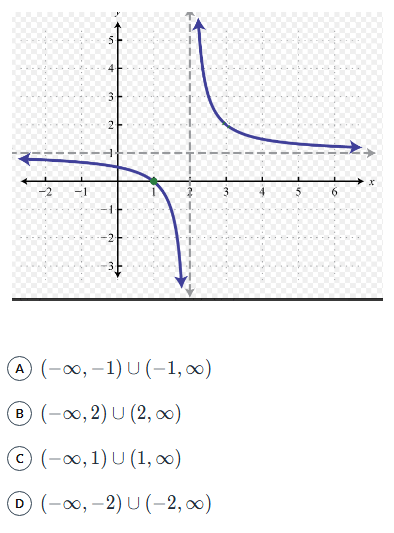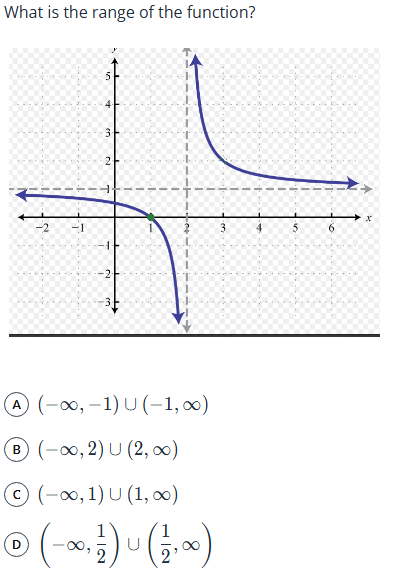What is the inverse of the relation shown?
{(-1,3), (4,2), (5,6), (7,1)}
{(3,-1), (2,4), (6,5), (1,7)}
What is the domain of the graph below?
B
What is the leading coefficient and degree of the polynomial function:
P(x)=-6x^5-2x^2+6
Leading Coefficient -6
Degree 5
Perform the indicated operation:
(-6+2x^5+5x^2)+(7x^5+4x^2+3)
12x^5+6x^2-3
The graph of 1/x is translated 4 units up and 2 units left. What is the equation of the translated graph?
y=1/(x+2)+4
Does this table represent inverse variation?
x | 2 4 6
y | 1 2 3
No
What is the range of the graph below?

C
Describe the end behavior of the polynomial function
P(x)=-6x^5-2x^2+6
x-> \infty, P(x)->-\infty
x->-\infty, P(x)->\infty
Perform the indicated operation:
(2x^4-3x^3-10)-(3x^3+2x-15)
2x^4-6x^3-2x+5
The graph of f(x)=x3 is translated 5 units up and has a stretch of 6. Write the equation of the translated function.
f(x)=6x^3+5
y varies inversely with x . If x = 4 when y = 12 , find the value of y when x=24
2
What is the equation of the vertical asymptote in the function
f(x) ={(x+2)(x-3)} /{(x+4)(x-3)
x=-4
What are the zeros of the polynomial function
p(x)=(x-1)(x+1)(x-5)
(-1,0),(1,0), (5,0)
Expand:
(3x+4y)2
9x^2+16y^2
3x^2+4y^2
3x^2+24xy+16y^2
9x^2+24xy+16y^2
9x^2+24xy+16y^2
Describe the transformations of the function
f(x)=1/(x-6)+2
Translated right 6 and up 2
Find the inverse function:
f(x) = 2x - 4
f-1(x) = 1/2x +2
What is the location of the hole in the function
f(x) ={(x+2)(x-3)} /{(x+4)(x-3)
x=3
Which statements about the following polynomial function are true?

a. The degree is even
b. The leading coefficient is negative
c. The degree is at least 6
d. The graph has a y-intercept of 150
e. p(x) has 4 distinct zeros
A, C, E
Factor completely
x^3+64
(x+4)(x^2-4x+16)
Describe the transformations of the function
f(x)=6/(x+3)
Stretch of 6 and translated left 3
f(x) = 4/3x - 2
f-1(x) = 3/4x + 1/2
What is the domain of the function
f(x) ={(x+2)(x-3)} /{(x+4)(x-3)
(-\infty, -4)\cup(-4,\infty)
f(x) is an even function with a positive LC
g(x) is an odd function with a positive LC
h(x) is the product of f and g, What would the leading coefficient and degree type be of h(x)?
A. Even and Positive
B. Even and Negative
C. Odd and Positive
D. Odd and Negative
C Odd and Positive
x=-3 is a zero of the polynomial. Use synthetic division and find all other zeros.
f(x)=2x^3-3x^2-23x+12
1/2, 4
Describe the transformations of the function
f(x)=-1/(x+2)
Reflected and translated left 2